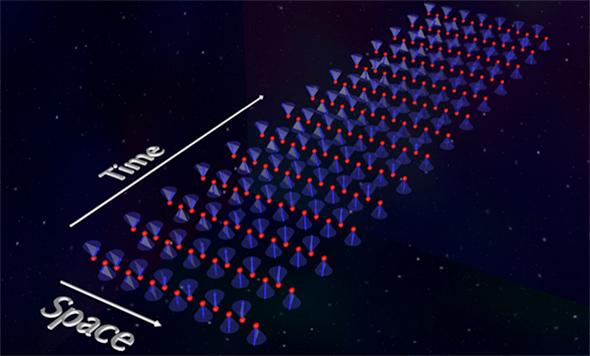Magnon circular birefringence: Polarization rotation of spin waves and its applications

Fig. 1: Linearly polarized states of observed antiferromagnetic spin waves. The polarization angle changes in space, which indeed is an analogous effect to the 'circular birefringence' of light. Credit: Taku J Sato
A “circular birefringence” effect, where photons travelling inside a certain kind of crystal have different speeds depending on their circular polarization is fairly common. In other words, left-handed photons might travel faster than right-handed photons. Such an effect specifically appearing under a finite external magnetic field is the Faraday effect, where light polarization rotates as it propagates along the crystal with the rotation angle linearly depending on the field.
There have been tremendous applications of this effect in modern optical and photonic technology. Optical isolator is one of such devices using the Faraday effect, whereas magneto-optical recording is based on its reflection variant, the Kerr effect.
Other systems also exhibit behaviors that resemble the circular birefringence effect. In an ordered magnetic material, a spin excitation can also propagate along the crystal. This excitation is called a “magnon.” Similar to the polarization states of photons, magnons in an antiferromagnet also have two distinct states: left-circular and right-circular state.
In most magnetic material, these two states have the same energy and are therefore indistinguishable. However, in a certain type of magnetic material, these two states of magnons behave differently due to a lack of spatial inversion symmetry in the crystal structure.
This phenomenon, called nonreciprocal magnons, has been predicted by Hayami et al. [2] However, there has been no direct observation of these nonreciprocal magnons until this work.
The research team performed neutron scattering experiments on single-crystal α-Cu2V2O7 and showed clear evidences of different energy-momentum dispersion relations between the left-circular and right-circular magnon propagation. The experimental data is confirmed by linear spin-wave calculations.
This work opens up a new regime of magnetic material which might find applications in magnon-based electronics (magnonics) such as the spin-wave field-effect transistor [3].
###
[1] G. Gitgeatpong, Y. Zhao, P. Piyawongwatthana, Y. Qiu, L. W. Harriger, N. P. Butch, T. J. Sato, and K. Matan, Phy. Rev. Lett. 119, 047201 (2017).
[2] S. Hayami, H. Kusunose, and Y. Motome, J. Phys. Soc. Jpn. 85, 053705 (2016).
[3] R. Cheng, M. W. Daniels, J.-G. Zhu, and D. Xiao, Sci. Rep. 6, 24223 (2016).
Media Contact
All latest news from the category: Physics and Astronomy
This area deals with the fundamental laws and building blocks of nature and how they interact, the properties and the behavior of matter, and research into space and time and their structures.
innovations-report provides in-depth reports and articles on subjects such as astrophysics, laser technologies, nuclear, quantum, particle and solid-state physics, nanotechnologies, planetary research and findings (Mars, Venus) and developments related to the Hubble Telescope.
Newest articles

Economies take off with new airports
A global study by an SUTD researcher in collaboration with scientists from Japan explores the economic benefits of airport investment in emerging economies using nighttime satellite imagery. Be it for…

CAR T–cell immunotherapy targets
Pan-cancer analysis uncovers a new class of promising CAR T–cell immunotherapy targets. Scientists at St. Jude Children’s Research Hospital found 156 potential CAR targets across the brain and solid tumors,…

Stony coral tissue loss disease
… is shifting the ecological balance of Caribbean reefs. The outbreak of a deadly disease called stony coral tissue loss disease is destroying susceptible species of coral in the Caribbean…





















